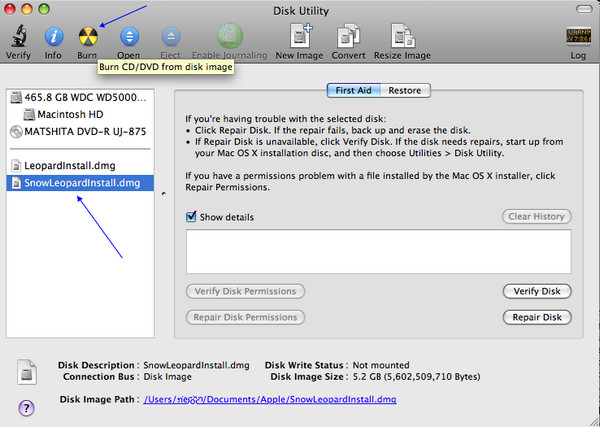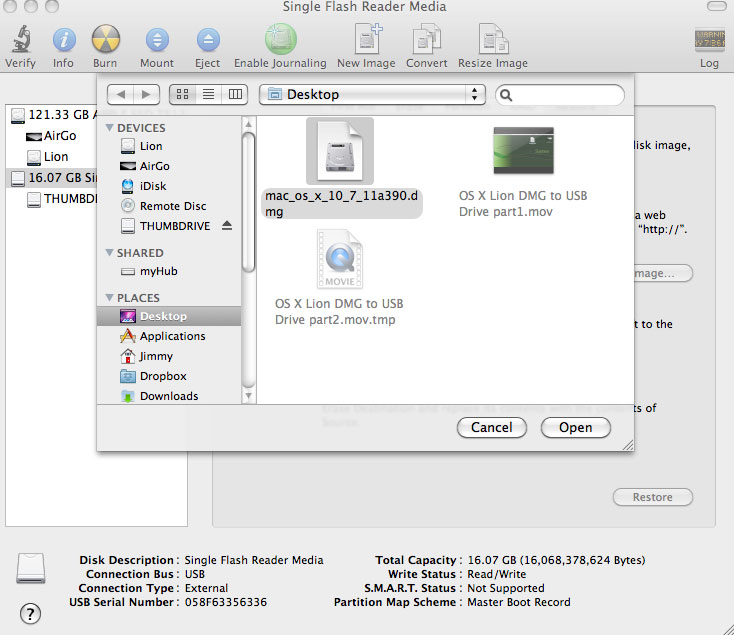Dec 16, 2019 Connect the USB flash drive or other volume that you're using for the bootable installer. Make sure that it has at least 12GB of available storage and is formatted as Mac OS Extended. Open Terminal, which is in the Utilities folder of your Applications folder. Type or paste one of the following commands in Terminal.
- Usb Flash Drive Not Recognized
- Dmg File On Usb Flash Drive Computer
- Dmg File On Usb Flash Drive Not Recognized

Follow the quick tutorial that has SOLVED 'the file is too large for the destination file system'. Roll down to the #complete solutions#.
Video source: https://www.youtube.com/watch?v=Jre_Zjhuaoc
Reason for the 'file is too large for the destination file system' error
'Yesterday, when I tried to copy some large files including Windows 10 ISO files, the backup images of my operating system, movies, personal video files, and other data to my 32 GB external hard drive, I received the error message saying 'The file is too large for the destination file system.' I don't know why it happened as there was enough free space on the disk. Can anyone help?'
When facing the 'The file is too large for the destination file system' issue in Windows 10/8/7 or any other previous version, you might not figure out that why you would not be able to copy the file to your external hard drive, USB drive or some other storage devices when there is sufficient free space.
The problem occurs because one of the files you want to transfer is larger than 4 GB and your external hard drive or USB flash drive is using the FAT32 file system, of which the maximum file size is 4GB. There is a built-in limitation in the FAT32 file system: Although the total size of the files you can store on a FAT32 drive could be up to 2TB, you cannot save an individual file that exceeds 4GB on it.
Workable solutions
After figuring out the reason for 'The file is too large for the destination file system' issue, you can fix it in Windows 10/8/7 or any other previous Windows version with ease by converting the file system to NTFS. Here we will introduce you with two easy solutions. We will show you how to use these two solutions to fix 'The file is too large for the destination file system' error with simple steps.
Solution 1: Formatting FAT32 to NTFS for free with Windows built-in feature
Formatting is the easiest way for you to convert FAT32 to NTFS. But it will erase all the existing data on the drive. So, it is recommended only when there are no files on your external hard drive or USB flash drive. If there are files existing on your storage device, you can back them up by manually copying or using free backup software in advance. Here's how to do it for free with Windows built-in format feature.
Step 1: Right-click on the USB drive or external hard drive.
Step 2: Click 'Format'.
Step 3: Change the type to NTFS.

Done!! Now you have fixed the issue 'The file is too large for the destination file system' and can successfully copy a file larger than 4GB to the external USB drive or hard drive.
Solution 2: Converting FAT32 to NTFS without data loss using third-party software
And if there are important data on your external hard drive or USB drive, you might need a better solution. Converting FAT32 to NTFS without data loss using the partition tool - EaseUS Partition Master, popular third-party partition software is an optimal choice. It allows you to fix 'The file is too large for the destination file system' issue without formatting. The program can work in Windows 10/8/7 or any other previous versions. Here is the guide.
Step 1: Install and launch EaseUS Partition Master on your computer.
Step 2: Select a FAT32 partition, right-click on it and select 'Convert to NTFS'. If you need to convert a storage device such as SD card or USB flash drive to NTFS, insert it into your PC first and repeat the previous operation.
Step 3: Click 'OK' on the pop-up dialog box to continue.
Step 4: Go to the upper left corner, click the 'Execute 1 Operation' button and you will see the operation details. Click 'Apply' and 'Finish' when the process completes.
After finishing all the steps, you can convert your USB flash drive, SD card, or external hard drive from FAT32 to NTFS and copy files larger than 4GB successfully.
The Bottom Line

Once you understand 'the file is too large for the destination file system' is caused by the FAT32 file system, the solution is specific: change the file system. If you use the Windows built-in features or utilities to convert the file system, you need to back up the files on the storage device first since the operations will erase the files on your device. Thus, if you want to convert FAT32 to another file system directly without data loss, using EaseUS Partition Master is more advisable for you.
If you are an avid Mac user using a Windows PC, and suddenly find a DMG file in your windows system, you would definitely want to open it up to see what it contains. Though the installation files or compressed files it contains will not be compatible with your windows PC, yet there are some ways you can check out what it withholds. But before proceeding with the ways to open or view a DMG file, it is better if we have a thorough knowledge of what a DMG file exactly is. DMG files are actually Mac OS disk image files. It is very similar to ISO files in windows, or rather a counterpart of ISO files.
The images usually comprise installation files of softwares and operating systems and sometimes, compressed files. Since you are using a windows PC, surely you won't be able to run it on your Window OS, but at least there are ways by which you can have a look at its contents. And that is what we are going to discuss in this article - ways to view the DMG files on Windows 10/7/8.
Way #1: Open DMG Files on Windows with 7-ZIP
7-ZIP is a lightweight freeware which is easily available on the internet market. It not only extracts DMG files but all other of compressed files, such as ZIP, CAB, ISO, RAR, WIM, etc. But we would restrict our discussion here only upto DMG. Read the steps below to know the tool's usage:
Step 1. Download the 7-ZIP program file in any of your working computer and install it.
Step 2. After installation is done, locate the DMG file that you wish to open or view in your directory or desktop, and right-click on it.
Step 3. From the context menu, click on '7-ZIP' which will not appear as a part of your system since installed.
Step 4. From the next sub-menu that follows click on 'Open archive' and your DMG file will be opened and you can view the contents inside.
Cons:
- You cannot view or extract files bigger than 4 GB.
- You cannot view or extract encrypted files.
- You are only allowed to extract 5 DMG files at a time.
Usb Flash Drive Not Recognized
Way #2: Open DMG Files with DMG Extractor
DMG Extractor is another professional tool to open and extract .dmg files without first converting them into .iso or .img files. It's interface is very user-friendly and even a beginner can use it without any difficulty. Just go through the steps below to pull off the task:
Step 1. First of all, download the DMG extractor program file from the internet and install it in your personal Windows PC.
Step 2. Run the application with admin rights and in the main UI of the tool's screen, click on 'open' button in the upper menu bar to browse the required DMG file. The file will be loaded into the software's screen.
Step 3. After the file is loaded, you will be displayed all the contents contained within the DMG file.
Dmg File On Usb Flash Drive Computer
Cons:
- You cannot view or extract files bigger than 4 GB.
- You cannot view or extract encrypted files.
- You are only allowed to extract 5 DMG files at a time.
Way #3: View DMG files on Windows with PowerISO
PowerISO is yet another very powerful professional tool which can open, burn, extract, create, edit, convert, any kind of disk image files. It can process every kind of image files, be it BIN, DMG, ISO, DAA, etc. Here we would burn the image file into a CD/DVD or USB and then will open it from the disk storage to check out what it contains. But before you head on the tool's usage, better have a look at its specifications to use it in a better way.
Step 1. Get the program file downloaded from the official website and install it in your Windows computer.
Step 2. Launch the utility with admin privileges and then insert a empty Disk (CD/DVD or USB) in your computer.
Step 3. Click on 'Tools' button from the menu bar and then click on 'Burn' option from the drop-down menu.
Step 4. Now the 'DMG Burner' option will be shown in the PowerISO Window's screen.
Step 5. Click on 'Browse' button to fetch the required DMG files from your computer's directory.
Step 6. Select the burning speed from the dialog box and then finally click on 'Burn' button to start the burning process.
Step 7. Once the image is burnt in your disk, open the disk from 'My computer' and click on the DMG file to view what it contains.
Conclusion:
After going through all the methods mentioned above, you must have realized by now that the first two tools implemented have got several demerits and thus can be not relied upon fully. So in order to have all the facilities with disk images, better stick to way 3 for a guarantee result.